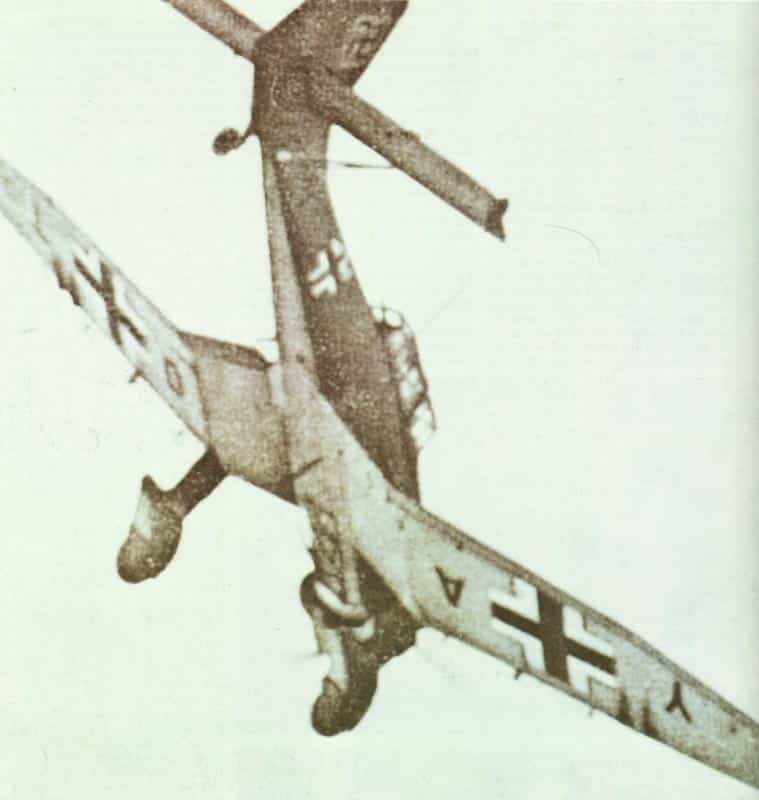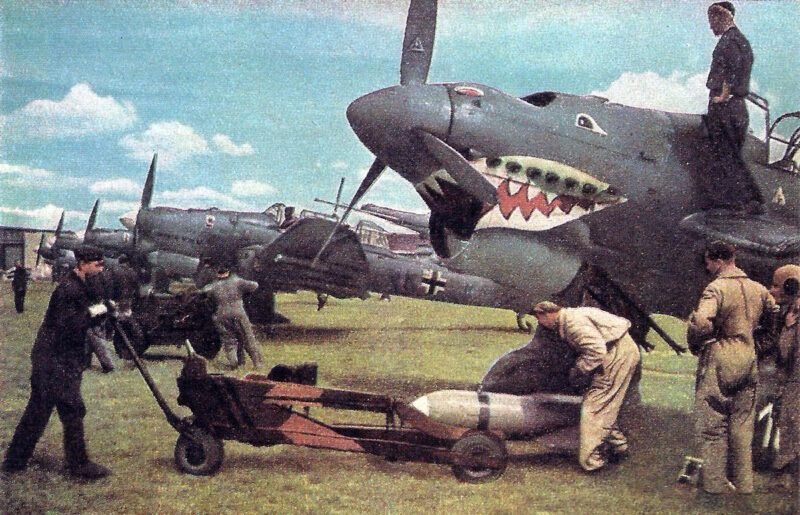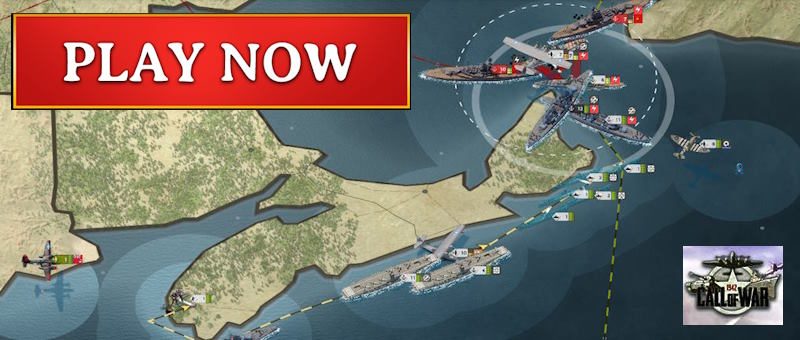Dive bombing tactics using the example of Stuka.
Following the tactics employed with the Junkers Ju 87 Stuka are described in detail; the dive-bombing methods used by the twin-engined Junkers Ju 88 were essentially similar, though the actual dive was somewhat shallower (60° during the early part of the war, reduced to 50° later).


Dive Bombing
Table of Contents
Dive bombing is a tactical airstrike maneuver where an aircraft approaches its target in a steep, controlled descent, allowing for greater accuracy in targeting.
Overview
Approach Angle: Pilots typically approach the target at a steep angle, often between 30 to 90 degrees, which helps in aiming and increases the impact of the bomb.
Speed and Altitude: Dive bombers usually operate at higher altitudes before the dive, allowing for greater speed during the descent. This speed can enhance the bomb’s impact and improve the pilot’s ability to evade ground fire after the release.
Target Identification: Precise target identification is crucial. Pilots often use visual cues or reconnaissance data to ensure they are striking the correct target.
Bomb Release: Timing is critical during the dive. Pilots must release the bomb at the right moment to ensure it hits the intended target. This requires practice and skill to judge distances accurately.
Evasion Maneuvers: After the bomb is released, pilots may perform evasive maneuvers to avoid anti-aircraft fire or enemy fighters. This can include pulling up sharply or executing a roll.
Coordination with Ground Forces: Effective communication with ground troops can enhance the effectiveness of dive bombing missions, ensuring that strikes are coordinated and that friendly forces are aware of the planned attacks.
Use of Technology: Modern dive bombing techniques may incorporate advanced targeting systems, GPS-guided munitions, and other technologies to improve accuracy and reduce collateral damage.
Historical Context: Dive bombing was notably used in World War II by forces like the German Luftwaffe and the U.S. Navy, with famous aircraft such as the Stuka and the Dauntless playing significant roles in various battles.
Overall, dive bombing requires a combination of skill, precision, and coordination to be executed effectively.
Procedure of the dive attack

The steep-dive attack was one of the most accurate ways of bombing. On the completion of their course at the specialist Dive Bomber school, crews were expected to be able to get 50% of their bombs within 25 m (27yd) of the center of the target; the comparable distance for high-flying horizontal bombers was two to three times larger. Furthermore, against operational targets, which were usually defended by anti-aircraft guns, the errors for all types of bombing were two or even three times as great as those indicated on the training ranges. Thus, although the dive bombing attack was not accurate enough to be worth-while against small, hard targets such as individual tanks, it was very effective against soft targets, such as motor vehicles, which were vulnerable to near misses.
Against (say) a circular fortification with a radius of 80yd (ca. 73 m), with moderately heavy gun defenses, a Staffel (squadron) of Ju87s stood a good chance of scoring four or five hits with large bombs.
In each case the nature of the target dictated the bomb load carried by the Ju 87; against a concreted fortification, for example, a single SD-500 would be used; against field artillery positions, a typical load would be one SC-250 under the fuselage and four SC-50s under the wings (the designation of a German high explosive bomb indicated the type of casing and the weight of the weapon in kilos).
When approaching their target the Ju 87s would, typically, fly in three-aircraft Vics (Ketten) at about 15,000ft (ca. 4,572 meters), cruising at 150mph (ca. 241 km/h). Larger formations would be made up of several of these Vics in line astern, with a spacing of about 300yd (ca. 274 meters) between aircraft, up to a usual maximum of about 30 machines (Gruppe strength). If there were fighters flying close escort, these would follow a weaving path behind and slightly above the dive-bombers; as the force neared the target the escort would split, one-third remaining at height while the remainder descended to about 3,000ft (ca. 914 meters) to be in position to protect the bombers from enemy fighters as they pulled out of their dives.
Prior to entering his dive the Ju 87 pilot switched on his reflector sight, trimmed the aircraft for the dive, set the pull-out altitude on the contact altimeter, closed the radiator flaps, throttled back the engine and opened the ventilation air supply to the windscreen (to prevent possible misting as the aircraft entered the moist air lower down). Finally, he switched on the wind-driven ‘Screamer’ (if required) and opened the dive brakes; the hydraulic operation of the brakes automatically lowered an elevator tab, to counter the severe nose-up trim-change which would otherwise result.
Once it was established in its dive, typically at an angle of 80°, the Ju 87 with extended dive-brakes gained speed only gradually. It took about 8,000ft (ca. 2,438 meters) for it to reach its limiting speed of about 350mph (ca. 563 km/h), after which its velocity remained constant. The accuracy of the attack depended upon the accuracy with which the selected dive angle was maintained. To assist him the pilot had etched lines on the side panels of his canopy, rather like a protractor, on which he could align the horizon and read off his angle; after some practice, however, pilots were able to judge their dive angle to within fine limits without having to resort to this aid.
A dive from 15,000ft (ca. 4,572 meters) to a release altitude of 3,000ft (ca. 914 meters) (usual for attacks against defended targets) took about 30sec, during which the pilot controlled his aircraft to hold the target in the center of his reflector sight.
Four seconds before the dive-bomber passed the pull-out altitude previously set on the contacting altimeter, the latter sounded a horn. When the horn ceased, at release height, the pilot pressed a button on his control column to actuate a powerful spring which returned the elevator trim tab to the neutral position; the aircraft, now in a tail-heavy configuration, began automatically to pull itself out of the dive. The pressing of the button had also started the run-down of the bomb-release distributor, and after a set time interval the bombs were released automatically; the special radius arm swung the fuselage bomb down and clear of the propeller disc.
After the pull-out the pilot regained control and retracted the dive brakes, opened the throttle, trimmed for level flight and made his getaway.

References and literature
Luftkrieg (Piekalkiewicz)
The Encyclopedia of Weapons of World War II (Chris Bishop)
Das große Buch der Luftkämpfe (Ian Parsons)
German Aircraft of World War 2 in Colour (Kenneth Munson)
Luftwaffe Handbook (Dr Alfred Price)
Combat Aircraft of World War II (Bill Gunston)









